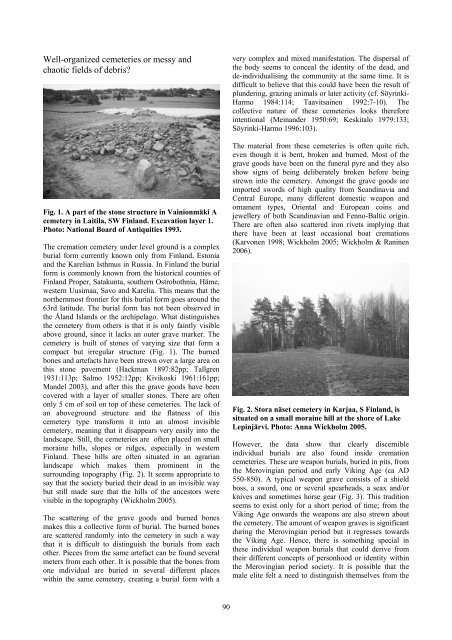The Materiality of Death - mikroarkeologi.se
The Materiality of Death - mikroarkeologi.se
The Materiality of Death - mikroarkeologi.se
Create successful ePaper yourself
Turn your PDF publications into a flip-book with our unique Google optimized e-Paper software.
Well-organized cemeteries or messy and<br />
chaotic fields <strong>of</strong> debris?<br />
Fig. 1. A part <strong>of</strong> the stone structure in Vainionmäki A<br />
cemetery in Laitila, SW Finland. Excavation layer 1.<br />
Photo: National Board <strong>of</strong> Antiquities 1993.<br />
<strong>The</strong> cremation cemetery under level ground is a complex<br />
burial form currently known only from Finland, Estonia<br />
and the Karelian Isthmus in Russia. In Finland the burial<br />
form is commonly known from the historical counties <strong>of</strong><br />
Finland Proper, Satakunta, southern Ostrobothnia, Häme,<br />
western Uusimaa, Savo and Karelia. This means that the<br />
northernmost frontier for this burial form goes around the<br />
63rd latitude. <strong>The</strong> burial form has not been ob<strong>se</strong>rved in<br />
the Åland Islands or the archipelago. What distinguishes<br />
the cemetery from others is that it is only faintly visible<br />
above ground, since it lacks an outer grave marker. <strong>The</strong><br />
cemetery is built <strong>of</strong> stones <strong>of</strong> varying size that form a<br />
compact but irregular structure (Fig. 1). <strong>The</strong> burned<br />
bones and artefacts have been strewn over a large area on<br />
this stone pavement (Hackman 1897:82pp; Tallgren<br />
1931:113p; Salmo 1952:12pp; Kivikoski 1961:161pp;<br />
Mandel 2003), and after this the grave goods have been<br />
covered with a layer <strong>of</strong> smaller stones. <strong>The</strong>re are <strong>of</strong>ten<br />
only 5 cm <strong>of</strong> soil on top <strong>of</strong> the<strong>se</strong> cemeteries. <strong>The</strong> lack <strong>of</strong><br />
an aboveground structure and the flatness <strong>of</strong> this<br />
cemetery type transform it into an almost invisible<br />
cemetery, meaning that it disappears very easily into the<br />
landscape. Still, the cemeteries are <strong>of</strong>ten placed on small<br />
moraine hills, slopes or ridges, especially in western<br />
Finland. <strong>The</strong><strong>se</strong> hills are <strong>of</strong>ten situated in an agrarian<br />
landscape which makes them prominent in the<br />
surrounding topography (Fig. 2). It <strong>se</strong>ems appropriate to<br />
say that the society buried their dead in an invisible way<br />
but still made sure that the hills <strong>of</strong> the ancestors were<br />
visible in the topography (Wickholm 2005).<br />
<strong>The</strong> scattering <strong>of</strong> the grave goods and burned bones<br />
makes this a collective form <strong>of</strong> burial. <strong>The</strong> burned bones<br />
are scattered randomly into the cemetery in such a way<br />
that it is difficult to distinguish the burials from each<br />
other. Pieces from the same artefact can be found <strong>se</strong>veral<br />
meters from each other. It is possible that the bones from<br />
one individual are buried in <strong>se</strong>veral different places<br />
within the same cemetery, creating a burial form with a<br />
very complex and mixed manifestation. <strong>The</strong> dispersal <strong>of</strong><br />
the body <strong>se</strong>ems to conceal the identity <strong>of</strong> the dead, and<br />
de-individualising the community at the same time. It is<br />
difficult to believe that this could have been the result <strong>of</strong><br />
plundering, grazing animals or later activity (cf. Söyrinki-<br />
Harmo 1984:114; Taavitsainen 1992:7-10). <strong>The</strong><br />
collective nature <strong>of</strong> the<strong>se</strong> cemeteries looks therefore<br />
intentional (Meinander 1950:69; Keskitalo 1979:133;<br />
Söyrinki-Harmo 1996:103).<br />
<strong>The</strong> material from the<strong>se</strong> cemeteries is <strong>of</strong>ten quite rich,<br />
even though it is bent, broken and burned. Most <strong>of</strong> the<br />
grave goods have been on the funeral pyre and they also<br />
show signs <strong>of</strong> being deliberately broken before being<br />
strewn into the cemetery. Amongst the grave goods are<br />
imported swords <strong>of</strong> high quality from Scandinavia and<br />
Central Europe, many different domestic weapon and<br />
ornament types, Oriental and European coins and<br />
jewellery <strong>of</strong> both Scandinavian and Fenno-Baltic origin.<br />
<strong>The</strong>re are <strong>of</strong>ten also scattered iron rivets implying that<br />
there have been at least occasional boat cremations<br />
(Karvonen 1998; Wickholm 2005; Wickholm & Raninen<br />
2006).<br />
Fig. 2. Stora nä<strong>se</strong>t cemetery in Karjaa, S Finland, is<br />
situated on a small moraine hill at the shore <strong>of</strong> Lake<br />
Lepinjärvi. Photo: Anna Wickholm 2005.<br />
However, the data show that clearly discernible<br />
individual burials are also found inside cremation<br />
cemeteries. <strong>The</strong><strong>se</strong> are weapon burials, buried in pits, from<br />
the Merovingian period and early Viking Age (ca AD<br />
550-850). A typical weapon grave consists <strong>of</strong> a shield<br />
boss, a sword, one or <strong>se</strong>veral spearheads, a <strong>se</strong>ax and/or<br />
knives and sometimes hor<strong>se</strong> gear (Fig. 3). This tradition<br />
<strong>se</strong>ems to exist only for a short period <strong>of</strong> time; from the<br />
Viking Age onwards the weapons are also strewn about<br />
the cemetery. <strong>The</strong> amount <strong>of</strong> weapon graves is significant<br />
during the Merovingian period but it regres<strong>se</strong>s towards<br />
the Viking Age. Hence, there is something special in<br />
the<strong>se</strong> individual weapon burials that could derive from<br />
their different concepts <strong>of</strong> personhood or identity within<br />
the Merovingian period society. It is possible that the<br />
male elite felt a need to distinguish them<strong>se</strong>lves from the<br />
90
















